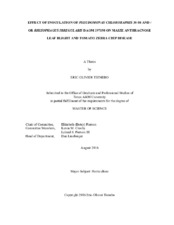| dc.contributor.advisor | Pierson, Elizabeth | |
| dc.creator | Tienebo, Eric-Olivier | |
| dc.date.accessioned | 2016-09-22T19:49:48Z | |
| dc.date.available | 2018-08-01T05:57:26Z | |
| dc.date.created | 2016-08 | |
| dc.date.issued | 2016-08-02 | |
| dc.date.submitted | August 2016 | |
| dc.identifier.uri | https://hdl.handle.net/1969.1/158069 | |
| dc.description.abstract | Anthracnose leaf blight (ALB) and Zebra Chip disease (ZC) represent serious threats to maize and Solanaceous crop production respectively. ALB control relies on resistant lines, but high genetic plasticity in the fungal causative agent, Colletotrichum graminicola, resulting in the evolution of new pathotypes makes it challenging to breed for durable genetic resistance. ZC control is based on antibiotic treatment against the causative agent ‘Candidatus Liberibacter solanacearum’ (CLso) and insecticide applications to control the psyllid vector, Bactericera cockerelli. However, this will lead to resistance emergence in the psyllids and CLso. A potential alternative is to boost host resistance by employing Plant Growth-Promoting Rhizobacteria (PGPR) and Arbuscular Mycorrhizal Fungi (AMF).
I found in vitro that the PGPR Pseudomonas chlororaphis 30-84 inhibited the growth of C. graminicola M1.001 via phenazine production. In vivo, the AMF Rhizophagus irregularis and P. chlororaphis 30-84 triggered effective systemic resistance to C. graminicola-induced foliar lesions on the susceptible B73 maize line. The level of disease control was similar to that of the resistant line W438. Both biocontrol agents (BCAs) reduced foliar fungal biomass. Coinoculation mirrored R. irregularis effect and revealed different and competitive mechanisms triggered by each BCA. Mutation of the ZMLOX12 gene enhanced disease severity on bacterized plants, whereas mycorrhized plants were still resistant. When introduced sequentially, I found no effect on the rate of root colonization by either organism on the other.
To investigate the role of mycorrhizae on Zebra Chip disease development and psyllid survival, I used a ‘no-choice’ assay, in which three couples of male and female B. cockerelli harboring either CLso haplotype A or B (LsoA and LsoB respectively) were placed on a single leaf. Despite reports suggesting mycorrhization facilitates feeding by phloem-feeding insects, R. irregularis substantially delayed and reduced symptoms of ZC diseases on ‘Moneymaker’ tomato as compared to non-mycorrhized plants treated with psyllids. Mycorrhization also impaired the survival of psyllid larvae from parents harboring LsoA but increased slightly the survival of those from parents harboring LsoB. PCR with specific CLso primers revealed that mycorrhization did not prevent CLso transmission by the insect or translocation to newly formed leaves. | en |
| dc.format.mimetype | application/pdf | |
| dc.language.iso | en | |
| dc.subject | Plant Growth-Promoting Rhizobacteria | en |
| dc.subject | Arbuscular Mycorrhizal Fungi | en |
| dc.subject | Anthracnose leaf blight | en |
| dc.subject | Zebra Chip disease | en |
| dc.subject | Colletotrichum graminicola | en |
| dc.subject | ‘Candidatus Liberibacter solanacearum’ (CLso) | en |
| dc.subject | Bactericera cockerelli | en |
| dc.subject | Pseudomonas chlororaphis 30-84 | en |
| dc.subject | Rhizophagus irregularis | en |
| dc.subject | ZMLOX12 gene | en |
| dc.subject | CLso haplotype A or B | en |
| dc.subject | Oviposition | en |
| dc.subject | larval survival | en |
| dc.subject | Induced Systemic resistance | en |
| dc.subject | Mycorrhizal Induced resistance | en |
| dc.subject | Maize | en |
| dc.subject | Tomato | en |
| dc.title | Effect of Inoculation of Pseudomonas Chlororaphis 30-84 and / or Rhizophagus Irregularis DAOM 197198 on Maize Anthracnose Leaf Blight and Tomato Zebra Chip Disease | en |
| dc.type | Thesis | en |
| thesis.degree.department | Horticultural Sciences | en |
| thesis.degree.discipline | Horticulture | en |
| thesis.degree.grantor | Texas A & M University | en |
| thesis.degree.name | Master of Science | en |
| thesis.degree.level | Masters | en |
| dc.contributor.committeeMember | Pierson III, Leland S. | |
| dc.contributor.committeeMember | Crosby, Kevin M. | |
| dc.type.material | text | en |
| dc.date.updated | 2016-09-22T19:49:48Z | |
| local.embargo.terms | 2018-08-01 | |
| local.etdauthor.orcid | 0000-0003-2912-7366 | |


